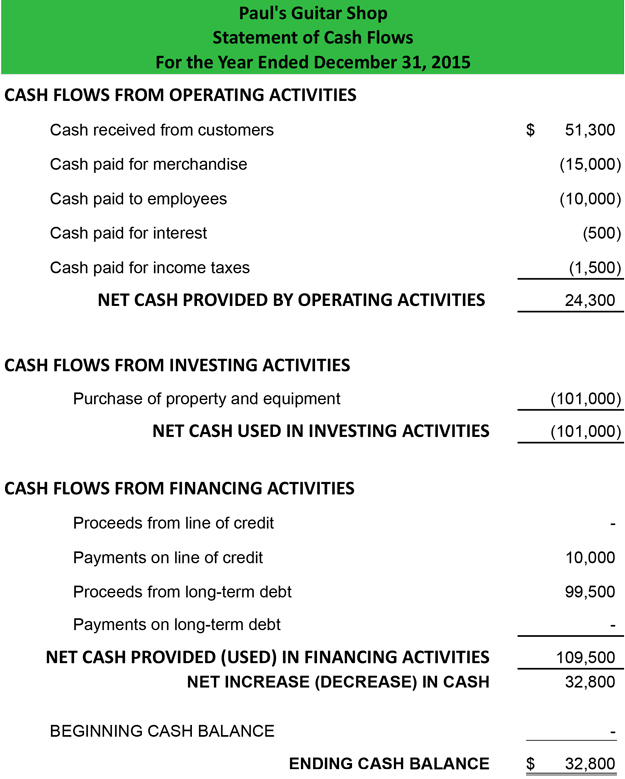What is the Statement of Cash Flows Direct Method?
The cash flow statement presented using the direct method is easy to read because it lists all of the major operating cash receipts and payments during the period by source. In other words, it lists where the cash inflows came from, usually customers, and where the cash outflows went, typically employees, vendors, etc.
After all of the sources are listed, the total cash payments are then subtracted from the cash receipts to compute the net cash flow from operating activities. Then the investing and financing activities added to arrive at the net cash increase or decrease. Let’s take a look at how this report is formatted and structured.
Format
Here’s a list of the most common types of receipts and payments used in the direct method format:
- Receipts received from Customers
- Payments paid to Suppliers
- Payments paid to Employees
- Interest Payments
- Income Tax Payments
As you can see, listing these payments gives the financial statement user a great deal of information where receipts are coming from and where payments are going to. This is one of the main advantages of the direct method compared with the indirect method. Investors, creditors, and management can actually see where the company is collecting funds from and whom it is paying funds to. The indirect method doesn’t list these types of details. That’s exactly why FASB recommends that all companies issue their statement of cash flows in the direct method.
The problem with this method is it’s difficult and time consuming to create. Most companies don’t record and store accounting and transactional information by customer, supplier, or vendor. Business events are recorded with income statement and balance sheet accounts like sales, materials, and inventory. It’s laborious for most companies to compile the information with this method.
For example, in order to figure out the receipts and payments from each source, you have to use a unique formula. The receipts from customers equals net sales for the period plus the beginning accounts receivable less the ending accounts receivable. Similarly the payments made to suppliers is calculated by adding the purchases, ending inventory, and beginning accounts payable then subtracting the beginning inventory and ending accounts payable.
Keep in mind that these formulas only work if accounts receivable is only used for credit sales and accounts payable is only used for credit account purchases. This is why most companies don’t issue this method. It’s difficult to gather the information.
Plus, the direct method also requires a reconciliation report be created to check the accuracy of the operating activities. The reconciliation itself is very similar to the indirect method of reporting operating activities. It stars with net income and adjusts non-cash transaction like depreciation and changes in balance sheet accounts. Since creating this reconciliation is about as much work as just preparing an indirect statement, most companies simply choose not to use the direct method.
I know what you are probably thinking. If you have to do an additional reconciliation, why is it called the direct method. It seems like a whole like more work. Well, it is. The reason why it’s called that has nothing to do with how much work is involved in preparing the report. It has to do with how the operating cash flows are derived. This method looks directly at the source of the cash flows and reports it on the statement. The indirect method, on the other hand, computes the operating cash flows by adjusting the current year’s net income for changes in balance sheet accounts.
This is the only difference between the direct and indirect methods. The investing and financing activities are reported exactly the same on both reports.
Let’s look at an example.
Example
Here’s an example of a cash flow statement prepared using the direct method.

As you can see, all of the operating activities are clearly listed by their sources. This categorization does make it useful to read, but the costs of producing it for outweigh the benefits to the external users. This is why FASB has never made it a requirement to issue statements using this method.




